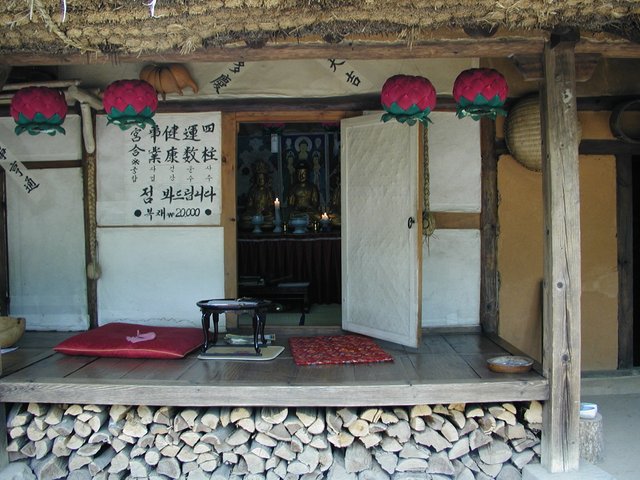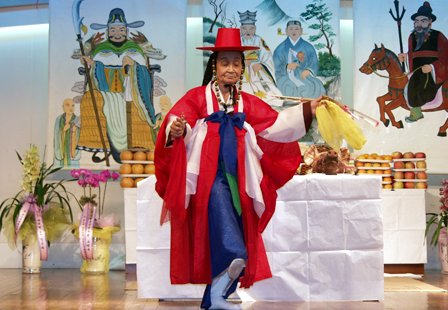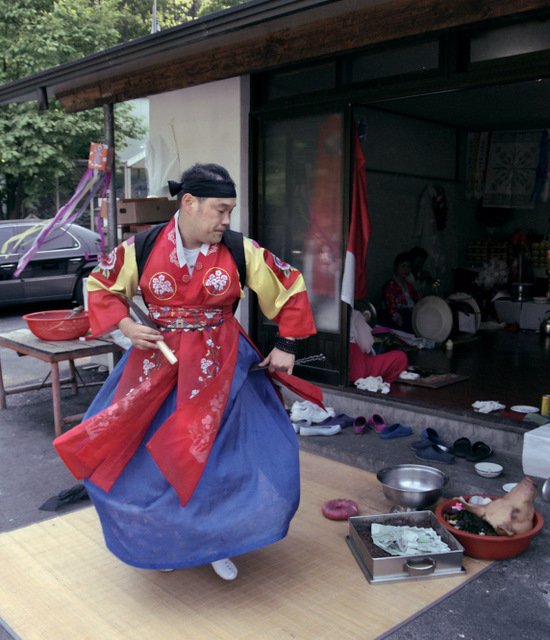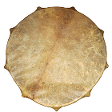Shaman Knowledge - The Shaman Culture of Korea
Introduction
Korea has 70 million inhabitants, divided into 3 countries: South Korea with 44 million, North Korea with 23 million and in the East of Manchuria in China live about 2 million. The language is related to the Altaic language group, and their culture has preserved its peculiarities between the influences of Japan and China.

Roots of culture
The cultural roots of the burial customs date back to the Kurgan burials from the Altai Mountains and are dated back to the Silla Dynasty, from the first century BC. until the ninth century AD. The gold crowns of the Silla dynasty are symbols of the kingship and are comparable to the shaman crowns of Siberia. Written sources document the title of the first king with "cliach'ung", which today is equated with shaman or teacher. This high position of the shamans or priests has been preserved to this day, so shamans are often invited to visit the various events throughout Korea, and their rituals and functions will now be enlightened.
Today, about 90% of shamans in Korea are women and the few men are dressed in women's clothes. Where this tradition comes from is not quite clear, the term "mudang" for a female shaman was first used in the early 13th century. Other terms are: mansin (f) and mugyök, pasu or shimbang (m).

Types of Shamans
In Korea the shamans in different categories are designated by independent names:
- "kangshinmu" - the spontaneous vision called them to become shaman
- "tan'gol" - hereditary shamans, with shaman ancestors
- "shimbang" - shamans with great spiritual powers
- "myöngdu" - shamans with special abilities to the realm of the dead and especially the children who died too early
Ceremonies
The ceremony is generally referred to as "kut", derived from the old word for repugnant or unhappy. As in large parts of Siberia, these rituals today witness a renaissance in South Korea and are carried out for different purposes.

I would like to introduce the most important rituals.
- "chaesu kut" ritual to get happiness and success in life
- "naerim kut" Inaugural ritual for the shaman's pupil or the new shaman
- "chinjok kut" A special form of the ritual in which the shaman strives for his spiritual development
- "chinogi kut" One of the rituals for the deceased, usually 3 weeks after death. From the Buddhist tradition, there are still several dates to perform these kinds of rituals
- "ssikkim kut" ritual for the deceased, to simplify the transition to the realm of the dead
If you get fancy on these ceremonies you may visit one of them in the center of the South Korean capital on the holy mountain Inwang almost daily. But do not forget to take a gift, better more.
Note: I have not been to Korea yet, but plan to travel there, the information on this article I have mixed from different sources with my experiences from Siberia.
News story: South Korean President ( Choi Soon-Sil) now faces wrath of shamans
Image credits:
Brendon Connelly (posted to Flickr as p5240124) CC BY-SA 2.0, via Wikimedia Commons
hplouffe CC BY 3.0, via Wikimedia Commons
Drpaluga CC BY-SA 3.0] oder GFDL, via Wikimedia Commons
See you next time!
Thank you for your attention!
Translated from my own post in German: https://steemit.com/kr/@schamangerbert/schamanenwissen-die-schamanenkultur-koreas
 SchamanGerbert
SchamanGerbert
Hi friend
Today I posted about shamanism in Korea ^^
I've often seen a scene where a moodang's gut.
However, it is strange to remember that I was scared of the sound of the moodang dancing and 'gut' in my memory.
Maybe because I felt horrible shamanism.
I want to come to Korea! Then we will change it :)
I am a good shaman, no bad ideas in my mind.
And yes, by searching for this article I saw some very strange things, which I never will do.
But I had to make 200 more posts till I got the money to fly to Korea :)
This is a really interesting read! Thanks for sharing this! I love Korea. I've been in Korea for about 3 years now. Koreans are very proud of their beautiful culture and history. You can go just about anywhere and witness different historical displays like sword fighting, wrestling, music...etc. But as far as the history of their shamans....well this article is the first time I've ever heard it mentioned. You could probably find it here if you look carefully. But it's not something that's largely on display to tourists like the rest of their culture is. I asked my husband about it and he simply said that people these days just don't believe in it. So, its a dying art. Which is too bad in my opinion. Maybe if we get the word out there about it to other tourists, it could experience a comeback. Who knows~
I know what you are talking about. It is funny (or not) that I got an unfollow for this article, the fear of the old culture is still burning in the heads of them. We have in Europa the very same situation, our old culture is celtic, and we have museums and stuff but the christian culture makes the people still in inquisition time I think. My work will be the unification of the culture, not more and not less (by deleting the fire in the heads). I have no fear of nothing.
I try to get more information and then continue in a new article about the old culture.
Great informative post with impressive photos! Thanks for sharing this with us!
I like to go to Korea this year, then you will get more :)
Great! Looking forward to it! 👍🏻